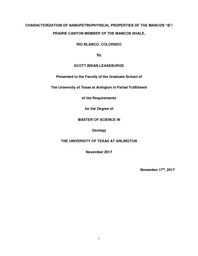
ATTENTION: The works hosted here are being migrated to a new repository that will consolidate resources, improve discoverability, and better show UTA's research impact on the global community. We will update authors as the migration progresses. Please see MavMatrix for more information.
Show simple item record
| dc.contributor.advisor | Hu, Qinhong | |
| dc.contributor.advisor | Wickham, John | |
| dc.creator | Leaseburge, Scott Brian | |
| dc.date.accessioned | 2018-02-15T20:12:43Z | |
| dc.date.available | 2018-02-15T20:12:43Z | |
| dc.date.created | 2017-12 | |
| dc.date.issued | 2017-12-04 | |
| dc.date.submitted | December 2017 | |
| dc.identifier.uri | http://hdl.handle.net/10106/27167 | |
| dc.description.abstract | Over the past decade hydrocarbon production from unconventional reservoirs has grown to become a significant source of North American domestic energy and will likely continue so for decades to come. However, production from unconventional reservoirs is plagued with low overall recovery and sharp declines in production. Low matrix permeability and poor pore connectively are significant factors limiting recovery and production. Research into the fluid flow characteristics of low permeability reservoirs can lead to extended initial production and greater overall recovery.
Technically recoverable unconventional oil and gas resources in the Mancos Shale of the Piceance Basin are estimated to be 66.3 tcf of natural gas, 74 million barrels of oil and 45 million barrels of natural gas liquids. The informally named Mancos “B” is an anomalously sandy interval of the Manos Shale deposited during the Late Cretaceous as a pro-delta plume. The Mancos “B” forms upward coarsening sequences consisting of mainly clastic sediments. The Mancos “B” has been a producing interval in the Douglas Creek Arch region of northwest Colorado since the late 1950’s.
This research focuses on the informal interval, Mancos “B”, sampled from three wells across Rio Blanco, Colorado. This study used a variety of methods that includes: X-Ray diffraction (XRD), total organic carbon (TOC), pyrolysis, core plug helium porosity and permeably, mercury intrusion capillary pressure (MICP), nitrogen gas physisorption, field emission-scanning electron microscopy (FE-SEM), fluid contact angle, and fluid imbibition.
The pore-size distributions of samples fell into two types. Type A distribution consists of a major peak between 500nm-800nm and a minor peak between 10nm-50nm. Type B pore-size distribution entails a single peak at approximately 10nm-50nm. Maturity plays a role in the development of organic hosted porosity (typically 10nm-50nm), but parameters such as lithofacies, as well as TOC content and kerogen type, are contributing variables to how the porosity evolves during maturation. Factors such as maturity, mineral composition, TOC, and depth/burial history all play a role in the final equation of a rock’s pore structure and surface-fluid characteristics. Lithofacies was found to likely be the strongest control on pore-size distribution type.
Samples tended to show a mixed wettability which is likely the result of a combination of hydrophilic minerals supported pore networks and hydrophobic organic matter-hosted pore networks. Imbibition results showed that type A samples had well-connected pore networks for both DI water and n-decane based on stage III slopes. Type B samples tended to have low DI water stage III slopes (0.1-0.3) and relatively high (0.4-0.5) n-decane stage III slopes. This suggests that type B samples have an affinity to contain a well-connected oil-wetting pore system likely due to the porosity that developed in organic matter during maturation but do not have the well-connected water-wetting pore networks that type A samples have. Type A’s well-connected pore networks are likely a result of lithofacies and the main distinction between type B samples. | |
| dc.format.mimetype | application/pdf | |
| dc.language.iso | en_US | |
| dc.subject | Mancos Shale | |
| dc.title | CHARACTERIZATION OF NANOPETROPHYSICAL PROPERTIES OF THE MANCOS “B”/ PRAIRIE CANYON MEMBER OF THE MANCOS SHALE, RIO BLANCO, COLORADO | |
| dc.type | Thesis | |
| dc.degree.department | Earth and Environmental Sciences | |
| dc.degree.name | Master of Science in Earth and Environmental Science | |
| dc.date.updated | 2018-02-15T20:14:50Z | |
| thesis.degree.department | Earth and Environmental Sciences | |
| thesis.degree.grantor | The University of Texas at Arlington | |
| thesis.degree.level | Masters | |
| thesis.degree.name | Master of Science in Earth and Environmental Science | |
| dc.type.material | text | |
| dc.creator.orcid | 0000-0001-8888-2877 | |
Files in this item
- Name:
- LEASEBURGE-THESIS-2017.pdf
- Size:
- 6.144Mb
- Format:
- PDF
This item appears in the following Collection(s)
Show simple item record


